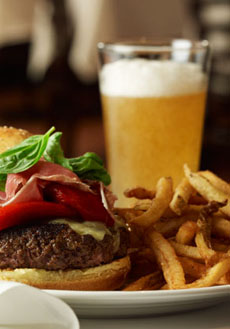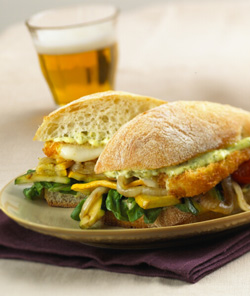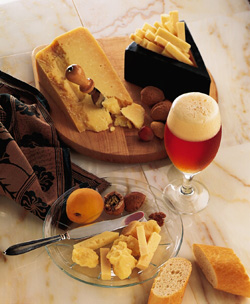

Beer is the perfect pairing with a burger and fries. Photo courtesy The Palm | New York City.
February 2005
Last Updated July 2015
|
 |
Beer Glossary: Different Types Of Beer
Page 5: Beer Terms ~ L To M
This is Page 5 of an eight-page glossary of different beer types and terms. Click on the black links below to visit other pages. Also see many other food glossaries, chock-full of information about your favorite foods.
This glossary is protected by copyright and cannot be reproduced in whole or part.
LACTIC FERMENTATION
The biochemical process in which yeast consume sugars such as glucose, fructose and sucrose, and convert them into “waste” products, alcohol (ethanol) and carbon dioxide. This reaction is critical in both beer-making, which requires the alcohol, and bread-making, which requires the carbon dioxide.
|
LAGER
Any beer made by bottom-fermentation. It is usually golden in color but sometimes can be dark. Lager requires a longer, colder fermentation than ale (which is a top-fermenting beer), and uses a different species of yeast, that tolerates cold temperatures well. The result of the cold fermentation is a lighter, crisper, smoother beer. Ale was the beer of England, and as the British colonized America, it was the beer of the Colonies. Lager beer was introduced to the U.S. during the German immigration of the early 1800s. It was immediately adopted and the country switched from being an ale-drinking country to a lager-drinking country. The only challenge was that brewing lager required a colder environment, 30°F to 40°F. Brewers would manufacture in caves or burrow into sides of mountains to find the right environment. Lager is the German word for storage place.
|
|

A lager with a grilled vegetable and cheese melt. Photo courtesy Wisconsin Milk Marketing Board. |
LAMBIC
A spontaneously-fermenting style of wheat beer, unique to Belgium. While most beers are distinguished by their flavors of hops and malt, lambic is an ancient style of beer that is naturally bone dry, acidic and effervescent. They are fermented differently from other beers. The wort, often kept in ventilated attics, is allowed to spontaneously ferment with wild, airborne yeasts. See framboise and gueuze.
LIGHT ALE
In England, light ale is the bottled counterpart of a draught bitter. In Scotland, “light” applied to beer indicates the lowest gravity (density) draught beer—coincidentally usually dark in color. Neither term implies a low-calorie beer.
LIGHT BEER
An American term indicating a watery pilsner-style beer that is lower in calories.
MALT
Beer-making starts with the grain. Barley is malted (soaked in water until it is partially germinated, then dried) which releases starches, which in turn are made into fermentable sugar. See beer-making.
MALT LIQUOR
Neither malty nor a liquor, usually a strong American lager intended for a cheap high. Some states require the term malt liquor to be applied to all beers of more than 5.0 percent by volume.
|
MÄRZENBIER or MÄR ZEN
An amber-red (auburn), smooth, mildly sweet, Vienna-style lager with a malty aroma, classically more than 5.5% alcohol by volume. It originated in Bavaria where it was originally brewed in March (März is the German word) and laid down in caves before the summer heat made brewing impossible. At the end of September, any remaining kegs were consumed during the two-week Oktoberfest. While some modern brewers make Märzen seasonally for Oktoberfest, others brew it year-round.
MASH
The mixture of ground malt and boiled grits that break down into fermentable sugars (the wort) in the beer-making process. See beer-making for the entire process.
|
|

Photo of Märzen, served with Asiago, Parmigiano-Reggiano, walnuts, bread and oranges, courtesy of Wisconsin Milk Marketing Board. |
MEAD
An alcoholic beverage made by fermenting honey and water, sometimes referred to as “honey wine.” It is plausibly humankind’s first fermented beverage. Sometimes, fruits, grains, hops or spices are added. The drink may be still, carbonated, or naturally sparkling; dry, semi-sweet, or sweet. The ABV can range from 8% to more than 20%. While mead is made the world over, in Homer’s Odyssey, it was drunk by the gods on Mount Olympus, earning it the name “nectar of the gods.”
MICROBREWERY
A boutique brewery that produces fewer than 15,000 barrels annually. The American microbrewery movement began in the 1980s, fueled by the increasingly sophisticated American palate and consumer dissatisfaction with the bland beers produced by the large commercial breweries. By 2000 there were more than 400 U.S. microbreweries and more than 1,000 brewpubs.
MILD ALE
A malty beer that originated in the Britain, in the 1600s or earlier. Modern mild ales are dark ales, generally with an ABV of 3% to 3.6%, although some have up to 6% ABV. The term “mild” originally meant a young beer, as opposed to an aged one. Today, it refers to a mildly hopped beer. Mild ale has declined in popularity since the 1960s, and can be difficult to find.
MÜNCHENER
A beer from Munich, for example, Münchener Dunkel, a full-bodied, malty and sweet-style dark lager beer that is a model for other “Bavarian-style” beers. If you come across one of these beers in the U.S., pair it with Bilinski chicken sausage, especially flavors with basil and sun-dried tomatoes.
Continue To Page 6: Terms Beginning With N To P
Go To The Article Index Above
Some terms in this glossary are © 2005 National Beer Wholesalers Association. All rights reserved. Other content is © Lifestyle Direct Inc. All rights reserved.

|






